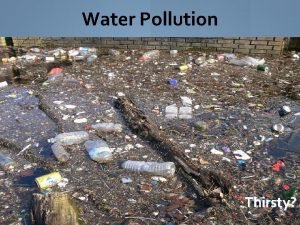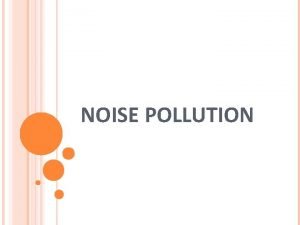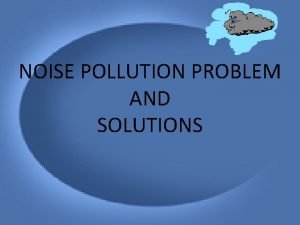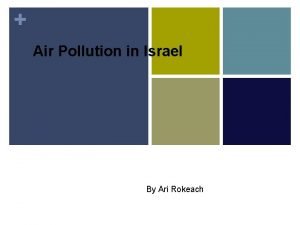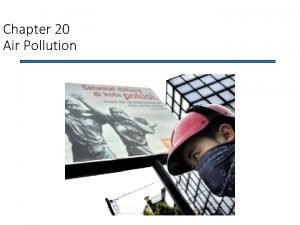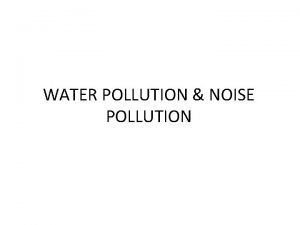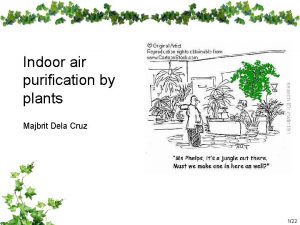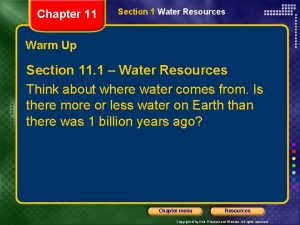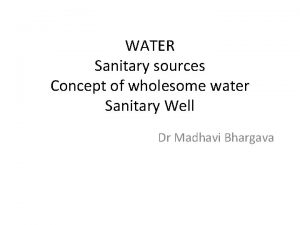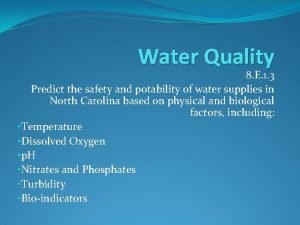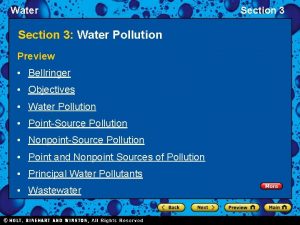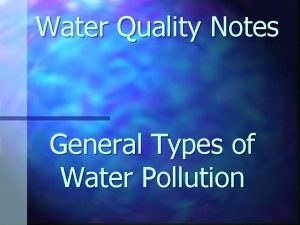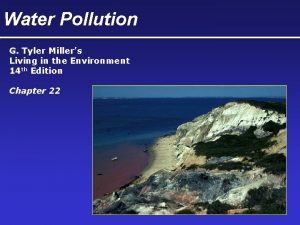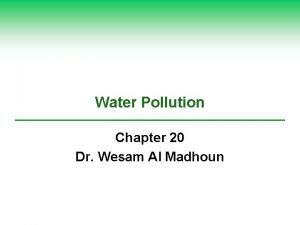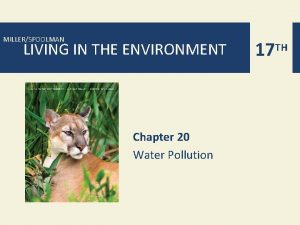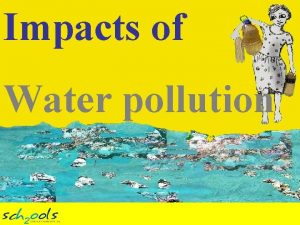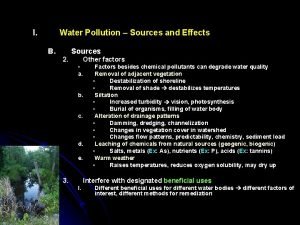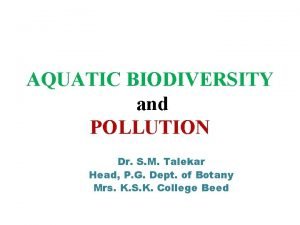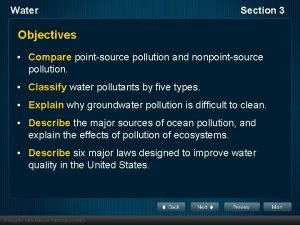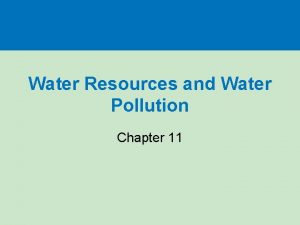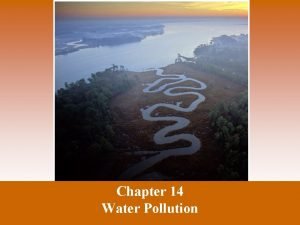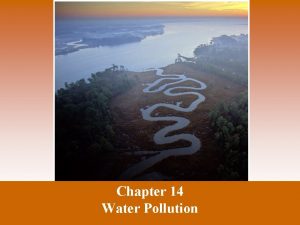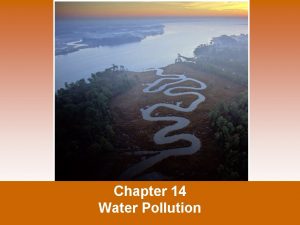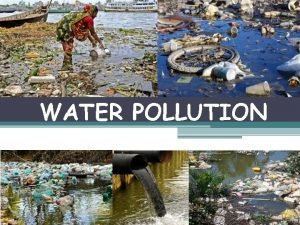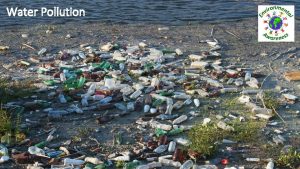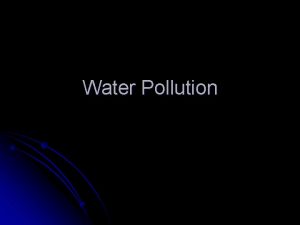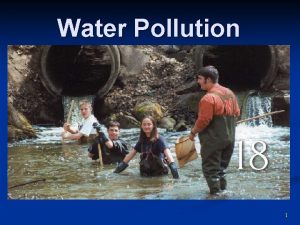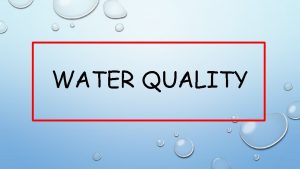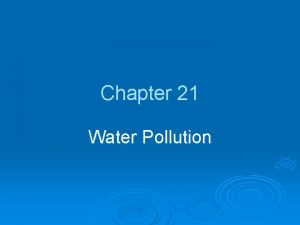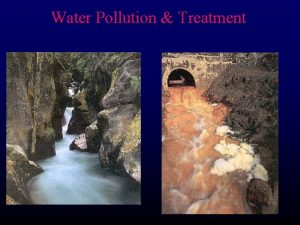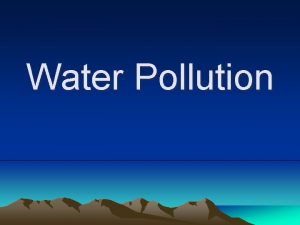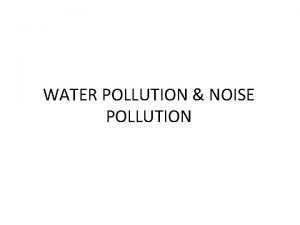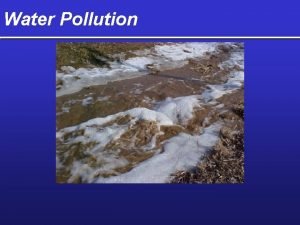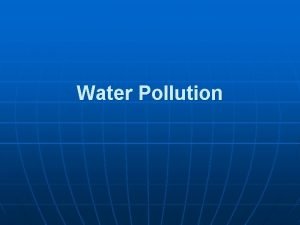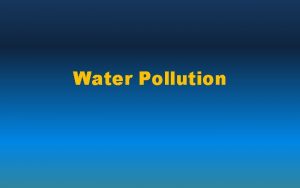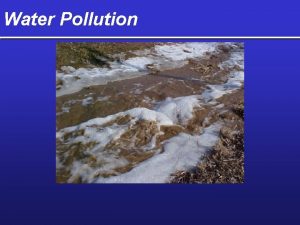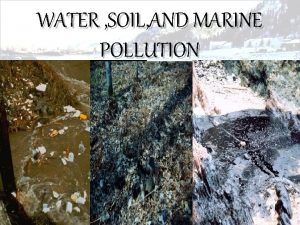Water Pollution Chapter 14 Sources of Pollution Water

































- Slides: 33

Water Pollution Chapter 14

Sources of Pollution • Water Pollution a. contamination of water with substances produced through human activities and have a negative effect on organisms http: //charlottesierraclub. org/2013/09/18/sept-20 -deadline-tell-epa-to-curb-toxic-water-pollution-from-coal-plants-2/

• Point Source vs. Nonpoint Source a. point source 1. distinct locations ex) waste pumped into stream b. nonpoint source 1. more diffuse areas ex) runoff http: //sanibelseaschool. org/classroom/eutrophication

• Common types of pollutants in water a. human and animal waste b. inorganic substances c. organic compounds d. synthetic organic compounds e. nonchemical pollutants

Human Wastewater • Wastewater a. water produced by human activities b. biggest challenge? 1. how to keep wastewater from polluting drinking water c. 3 concerns 1. decomposition 2. nutrient release 3. disease-causing organisms http: //www. epa. gov/research/endocrinedisruption/wastewater. htm

• Decomposition of wastewater a. oxygen-demanding waste 1. organic matter that enters a body of water and feeds the growth of the decomposers 2. biochemical oxygen demand (BOD) 3. dead zones - area of little life due to lack of oxygen http: //www. pbs. org/newshour/rundown/the-gulf-of-mexico-has/

• Release of nutrients a. nitrogen and phosphorus - soaps and detergents in addition to decomposition b. eutrophication

• Disease-causing organisms a. pathogens – bacteria, viruses and parasites that can cause an illness ex) cholera, hepatitis top two worldwide b. more common in developing countries

c. prevention 1. provide safe drinking water 2. proper sanitation 3. proper hygiene d. indicator species 1. used to detect if pathogen is in drinking water - most common is fecal coliform bacteria * e. coli

Treating Wastewater • Overall approach to various methods breakdown of organic matter by bacteria into CO 2, nitrate, and phosphate • 2 most common a. septic systems b. sewage treatment plants • Treatment of livestock waste – manure lagoons

• Septic Systems a. rural areas, low population density, lots of land b. 2 parts septic tank and leach field c. septic tank 1. receives wastewater from house 2. three layers - scum - septage - sludge d. advantage - no electricity needed http: //hvceo. org/regionalplan_wastewatertreatment. php

• Sewage Treatment Plants a. larger population densities, less open land b. developed countries - centralized plant - receives wastewater through network of underground pipes Sugar Creek Wastewater Treatment Plant Charlotte, NC http: //www. hdrinc. com/portfolio/sugar-creek-wastewater-treatment-plant-expansion-facility-plan

c. Process of sewage treatment plant 1. primary treatment - Goal “solid waste material to settle out of wastewater” (sludge)

2. secondary treatment - Goal “produce CO 2, nitrogen, and phosphorus by using bacteria to breakdown the majority of the organic matter in the water

3. tertiary treatment - Goal “release a wastewater that is as close to the quality of the body of water it is going back to”

• Manure Lagoons a. large, human-made ponds lined with rubber to prevent leakage of manure into the groundwater b. drawback - leak could happen in the liner * contaminate groundwater - applying manure as fertilizer * runoff into nearby water

Heavy Metals and Other Substances – Human Health and Environment • Nitrogen and phosphorus a. overfertilizing the H 2 O • Inorganic compounds a. lead, arsenic, mercury • Acids • Synthetic compounds a. pesticides, pharmaceuticals, and hormones

• Lead a. contamination 1. H 2 O passing through pipes of older homes, brass fittings, solder b. who it affects 1. fetuses and infants 2. damage to brain, nervous system, and kidneys c. solution 1. require lead-free pipe installation http: //www. faqs. org/nutrition/Kwa-Men/Lead-Poisoning. html

• Arsenic a. occurs naturally in Earth’s crust and dissolves in groundwater (contamination) b. contributions to increased amounts 1. mining 2. wood preservatives c. Symptoms 1. cancers of skin, lungs, kidneys, and bladder d. solution 1. fine membrane filtration 2. distillation 3. reverse osmosis http: //www. bicpaj. rodos 9. net/800 x 600/22. jpg

• Mercury a. naturally occurring in water b. source 1. burning of coal (coal-burning power plants) 2. incineration of garbage, hazardous waste, and dental supplies 3. petroleum (Hg and Lead) c. symptoms 1. damage of CNS d. solution 1. cement plants reduce emissions by 81% https: //nmtracking. org/environ_exposure/contaminants/mercury/

• Acid Deposition a. source 1. coal-burning power plants b. formation 1. release of SO 2 and NO 2 into atmosphere and converted into sulfuric acid 2. falls as wet or dry acid deposition c. solution 1. coal scrubbers http: //www. daviddarling. info/encyclopedia/A/AE_acid_rain. html

d. Acid mine drainage 1. due to flooded abandoned underground mines 2. pyrite (type of rock) breaks down water into hydrogen and iron ions producing acidic water http: //microbewiki. kenyon. edu/index. php/Acid_mine_drainage

• Synthetic Organic Compounds a. “human-made” b. pesticides 1. 3 concerns a. pesticides kill a wide variety of related organisms instead of just targeted species b. can alter other physiologic functions ex) DDT c. inert ingredients ex) Roundup

c. pharmaceuticals and hormones 1. ~50% of streams contain antibiotics and reproductive hormones 2. 80% contain nonprescription drugs 3. 90% contain steroids 4. low concentrations and do not yet pose environmental or human risk

d. industrial compounds 1. “use in manufacturing” 2. dumped directly into water (disposal) 3. Cuyahoga River of Ohio 4. PCBs - used in producing plastics - long-term persistence - lethal carcinogen if ingested 5. PBDEs - flame retardent

Oil Pollution and Water • Oil a. persistent b. spreads below or on surface of water c. leaves thick, viscous covering on shorelines d. sources of oil in water 1. leak in oil platform 2. spills from oil tankers 3. naturally occurring (60%) http: //www. fcmlaw. com/blog/file-a-bp-oil-spill-claim-before-april-2014/

e. solution 1. containment booms – open ocean 2. absorbent materials – shorelines 3. chemicals 4. genetically engineered bacteria http: //gulfoilspillimages. com/images/v/bp-oil-spill-images/oil+containment+boom. html

Solid Waste and Water • Discarded materials from houses and industries • “garbage” • Not a toxic hazard • Dangerous to marine organisms http: //enviropolicyintro. wordpress. com/2013/04/26/reduce-reuse-recycle/

Sediment Pollution and Water • Sediment - sand, silt, and clay carried by moving water and eventually settles when water slows down • Result of human activities a. construction b. plowed agricultural fields c. removal of natural vegetation

• Results in brown, cloudy water • Decreases the amount of sunlight that penetrates the water, decreasing photosynthesis http: //www. epa. ohio. gov/dsw/nps/index. aspx

Thermal Pollution and Water • When human activities cause a big change in the temperature of the water • Most common cause – steel mills and electric power plants • Solution a. cooling towers http: //thermalpollutionerikabudny. weebly. com/thermal-pollution. html

Water Regulation • Clean Water Act – 1972 a. maintains chemical, physical, and biological properties of natural water b. defines acceptable limits of various pollutants c. issues permits to industries on amounts of pollution allowed to be discharged into water d. DOES NOT ADDRESS GROUNDWATER CONTAMINATION

• Safe Drinking Water Act a. includes groundwater contamination b. sets national standards for safe drinking water c. establishes “maximum containment levels (MSL)” for 77 different substances in both surface and groundwater
 Importance water resources
Importance water resources Examples of point source pollution
Examples of point source pollution Print sources of information
Print sources of information Water and water and water water
Water and water and water water Zone of areation
Zone of areation The solution of noise pollution
The solution of noise pollution Noise pollution causes
Noise pollution causes Ari rokeach
Ari rokeach Two sources of air pollution
Two sources of air pollution Example of noise pollution
Example of noise pollution Define mobile sources of air pollution
Define mobile sources of air pollution Indoor air pollutants
Indoor air pollutants Control measures of water pollution
Control measures of water pollution Introduction about water pollution
Introduction about water pollution Chapter 11 section 2 water use and management
Chapter 11 section 2 water use and management Sanitary well psm
Sanitary well psm 10 sources of water
10 sources of water Sources of water
Sources of water Predict the sources of water
Predict the sources of water Chapter 2 income sources
Chapter 2 income sources Class 8 english chapter 7 water water everywhere
Class 8 english chapter 7 water water everywhere Section 3 water pollution
Section 3 water pollution Water pollution through the years
Water pollution through the years What are the terrible twelve water pollution
What are the terrible twelve water pollution Solutions to water pollution
Solutions to water pollution Soil contamination effects on human health
Soil contamination effects on human health Air pollution consequences
Air pollution consequences Soil pollution images diagram
Soil pollution images diagram How to reduce water pollution
How to reduce water pollution Effects of water pollution
Effects of water pollution Ddt water pollution
Ddt water pollution What are 5 effects of water pollution?
What are 5 effects of water pollution? Aims and objectives of water pollution
Aims and objectives of water pollution How to help reduce water pollution
How to help reduce water pollution

